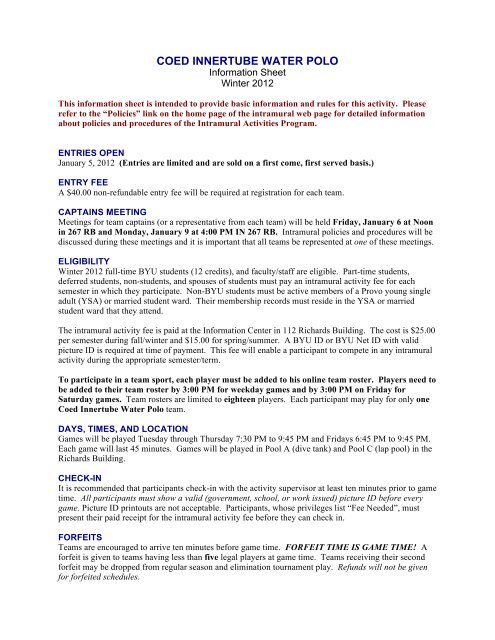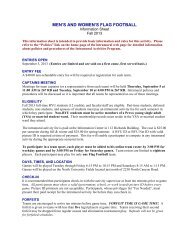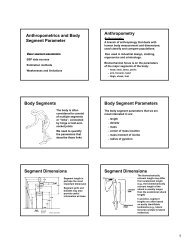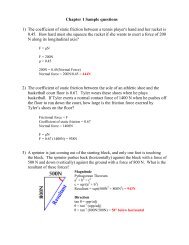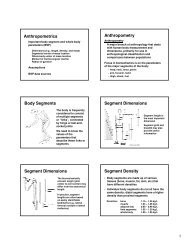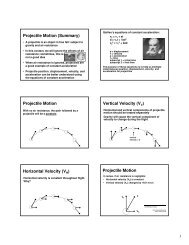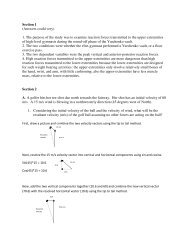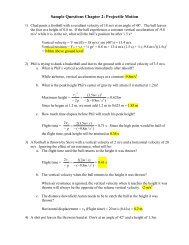Create successful ePaper yourself
Turn your PDF publications into a flip-book with our unique Google optimized e-Paper software.
COED INNERTUBE WATER POLO<br />
Information Sheet<br />
Winter 2012<br />
This information sheet is intended to provide basic information and rules for this activity. Please<br />
refer to the “Policies” link on the home page of the intramural web page for detailed information<br />
about policies and procedures of the Intramural Activities Program.<br />
ENTRIES OPEN<br />
January 5, 2012 (Entries are limited and are sold on a first come, first served basis.)<br />
ENTRY FEE<br />
A $40.00 non-refundable entry fee will be required at registration for each team.<br />
CAPTAINS MEETING<br />
Meetings for team captains (or a representative from each team) will be held Friday, January 6 at Noon<br />
in 267 RB and Monday, January 9 at 4:00 PM IN 267 RB. Intramural policies and procedures will be<br />
discussed during these meetings and it is important that all teams be represented at one of these meetings.<br />
ELIGIBILITY<br />
Winter 2012 full-time BYU students (12 credits), and faculty/staff are eligible. Part-time students,<br />
deferred students, non-students, and spouses of students must pay an intramural activity fee for each<br />
semester in which they participate. Non-BYU students must be active members of a Provo young single<br />
adult (YSA) or married student ward. Their membership records must reside in the YSA or married<br />
student ward that they attend.<br />
The intramural activity fee is paid at the Information Center in 112 Richards Building. The cost is $25.00<br />
per semester during fall/winter and $15.00 for spring/summer. A BYU ID or BYU Net ID with valid<br />
picture ID is required at time of payment. This fee will enable a participant to compete in any intramural<br />
activity during the appropriate semester/term.<br />
To participate in a team sport, each player must be added to his online team roster. Players need to<br />
be added to their team roster by 3:00 PM for weekday games and by 3:00 PM on Friday for<br />
Saturday games. Team rosters are limited to eighteen players. Each participant may play for only one<br />
<strong>Coed</strong> <strong>Innertube</strong> <strong>Water</strong> <strong>Polo</strong> team.<br />
DAYS, TIMES, AND LOCATION<br />
Games will be played Tuesday through Thursday 7:30 PM to 9:45 PM and Fridays 6:45 PM to 9:45 PM.<br />
Each game will last 45 minutes. Games will be played in Pool A (dive tank) and Pool C (lap pool) in the<br />
Richards Building.<br />
CHECK-IN<br />
It is recommended that participants check-in with the activity supervisor at least ten minutes prior to game<br />
time. All participants must show a valid (government, school, or work issued) picture ID before every<br />
game. Picture ID printouts are not acceptable. Participants, whose privileges list “Fee Needed”, must<br />
present their paid receipt for the intramural activity fee before they can check in.<br />
FORFEITS<br />
Teams are encouraged to arrive ten minutes before game time. FORFEIT TIME IS GAME TIME! A<br />
forfeit is given to teams having less than five legal players at game time. Teams receiving their second<br />
forfeit may be dropped from regular season and elimination tournament play. Refunds will not be given<br />
for forfeited schedules.
EQUIPMENT<br />
The goals, innertubes and game balls will be provided by Intramural Activities.<br />
UNIFORMS<br />
Participants (both men and women) must wear their own swimsuits into the RB swimming pool. The<br />
following standards will apply: For the women- a modest one-piece suit or a modest tankini suit which<br />
overlaps and can be tucked in if necessary. For the men- swim trunks with at least a 3-inch inseam.<br />
OFFICIALS<br />
The Office of Intramural Activities will provide all officials. Officials and supervisors assigned to your<br />
game have the authority to make decisions on any point not specifically covered by rules of the game or<br />
by intramural policies.<br />
LIABILITY<br />
All participants play at their own risk and must acquire their own insurance.<br />
SPIRIT OF SPORTSMANSHIP<br />
“Athletics are explosive, as any of us know who have participated in them. The problem therefore, is to<br />
do everything that is fair and honorable to win, and also to know the line where sportsmanship stops and<br />
mockery starts. Stop short of winning if integrity is to be impaired…. Sportsmanship is the spirituality in<br />
athletics” (The Teachings of Ezra Taft Benson, 436-438).<br />
Sportsmanship is everyone's responsibility. We hope that everyone will conduct himself in a mature and<br />
friendly manner. Team captains are responsible for the conduct of their players and their spectators. The<br />
BYU Intramural Program has identified the following principles as our “Spirit of Sportsmanship”<br />
guidelines. We encourage all employees, participants, and spectators to incorporate these principles on<br />
and off the playing field.<br />
1. Live with integrity: We believe in being honest, true, chaste, benevolent, virtuous, and in doing<br />
good to all men… (Thirteenth Article of Faith). Be consistent with who you are in all situations.<br />
“We are what we repeatedly do; excellence, then, is not an act but a habit” (Aristotle).<br />
2. Be accountable: The gift of agency allows us the ability to choose right from wrong. Although<br />
we are free to choose our actions, we are not free to choose the consequences. Other people<br />
cannot determine our feelings or thoughts. We are each accountable for the things we do and say<br />
and should never blame others for our behavior.<br />
3. Live the Golden Rule: And as ye would that men should do to you, do ye also to them likewise<br />
(Luke 6:31). “Good sportsmanship includes thoughtfulness and concern for others…humility in<br />
victory; and calmness and composure in defeat. It is fair play, following both the spirit and the<br />
letter of the rules. It is the Golden Rule in action on the playing court, on the bench, and in the<br />
stands” (Physical Fitness, Sports, & Recreation Manual. The Church of Jesus Christ of Latterday<br />
Saints, 1984; 17).<br />
4. Play by the rules: Do not push limits or escalate your level of physical play to match the style of<br />
enforcement. Playing to the call or whistle instead of by the established rules of the game is a<br />
violation of integrity and honesty. This style of play endangers the other players. Play hard, but<br />
play fair and honor the rules.<br />
5. Turn the other cheek: If you begin to feel unsettled or agitated, take a personal timeout. Step<br />
back to gain composure and perspective. Retaliation does not solve conflict—it only compounds<br />
the situation. Be meek. Ye have heard that it hath been said, An eye for an eye, and a tooth for a<br />
tooth…whosoever shall smite thee on thy right cheek, turn to him the other also (Matthew 5: 38-<br />
39).
6. Be gracious: Compliment your opponent after a good play. Focus on the good. Build people<br />
up—do not tear people down. Be genuine when you congratulate your opponent. Demonstrate<br />
gratitude for the efforts of the officials and activity supervisors. A soft answer turneth away<br />
wrath: but grievous words stir up anger (Proverbs 15:1).<br />
7. Have fun: …Men are, that they might have joy (2 Nephi 2:25). Be safe, play fair, and enjoy the<br />
experience.<br />
YELLOW/RED CARD SYSTEM<br />
A yellow/red card system is used to monitor unsportsmanlike behavior and improper conduct. A<br />
participant who receives a yellow card will be required to sit out for two minutes of game time. A<br />
participant who receives a red card shall be ejected from the game and must leave the field/court before<br />
play resumes. A team with a carded player must play with one less player until the penalty time has<br />
expired (Yellow = 2 minutes & Red = 4 minutes).<br />
The following are examples of yellow/red card offenses:<br />
Yellow Card: Non-directional profanity; arguing; rough play; taunting opponents.<br />
Red Card: Illegal participation; directional profanity; flagrant contact; fighting; threatening behavior.<br />
TOURNAMENT INFORMATION<br />
There will be three divisions (upper, middle, and lower) for regular season play. At the conclusion of<br />
regular season play, eligible teams will be re-evaluated and placed in the tournament division that best fits<br />
their ability. Teams will be given a ranking between 1 and 5 (5 being the highest) for each regular season<br />
game they play. To receive a 5 ranking, a team must be proficient in each of the following criteria:<br />
1. Team has a goalie that blocks the majority of shots.<br />
2. Players can move quickly and properly in their innertubes.<br />
3. Team works well together and they are able to pass accurately to each other.<br />
4. Players have a proficient defense.<br />
5. Females on the team are athletic and able to score goals.<br />
At the conclusion of regular season play an overall average of each team’s rankings will be computed and<br />
eligible teams will be placed in the tournament division that best fits their ability. Important tournament<br />
dates are listed below.<br />
� Tournament classification rankings will be posted by 4:00 PM on Monday, February 27.<br />
� Teams will have until 4:00 PM on Thursday, March 1 to challenge classification rankings.<br />
� Tournament brackets will be posted by 4:00 PM Friday, March 2.<br />
� Tournament play begins Tuesday, March 6.<br />
RULES<br />
I. PLAYERS AND EQUIPMENT<br />
Section 1 - Players<br />
a. Teams consist of seven players: one goalkeeper (which must be a male) plus six additional<br />
players with a maximum of three men (excluding the goalkeeper). A team must have a minimum<br />
of five players to begin.<br />
b. Goalkeeper: For safety reasons, this player must be a male, and cannot wear glasses. He shall<br />
have a blue innertube, distinctive from all others.<br />
Section 2 - Equipment<br />
a. The innertubes used are standard, fully inflated, and supplied by the Intramural Department.<br />
Intentional deflating of the innertubes will result in a penalty throw.
. Colored tubes are used to designate opposite teams and goalies.<br />
II. PERIODS, TIME FACTORS, DELAY OF GAME, AND SUBSTITUTIONS<br />
Section 1 - Periods<br />
a. Games consist of two 15-minute halves with a two-minute halftime.<br />
b. Overtime (Tournament only): One three-minute period shall be played. The clock will stop in the<br />
last minute for penalties and violations if the score differential is 3 points or less. Any additional<br />
overtime periods will be played to sudden death.<br />
Section 2 - Time factors<br />
a. The clock will run continuously except during time-outs and injuries.<br />
b. If a team is within 3 points, the clock will stop for penalties and violations during the last two<br />
minutes of the second half.<br />
c. Each team is entitled to two time-outs per game. During tournament, one time-out is awarded in<br />
overtime. Unused time-outs do not carry over.<br />
Section 3 - Delay of game<br />
When the whistle blows, everyone must freeze. Penalty: The first offense of the game will be a<br />
warning for both teams; after this warning, a penalty throw will be given to the opposing team<br />
following each offense.<br />
Section 4 - Substitutions<br />
a. A live substitution rule will be used. The player subbing out must bring his tube to either ladder<br />
and exit there. The player subbing in must wait until his/her teammate is out of the pool before<br />
entering the tube.<br />
b. Goalkeeper switches can only occur during time-outs, at halftime, or after a goal is scored - with<br />
permission from the referee.<br />
c. Any violation of these substitution rules will result in a penalty throw.<br />
III. BALL IN PLAY, BALL POSSESSION, AND BALL CONTROL<br />
Section 1 - Method of Play<br />
a. Each team lines up at their respective end of the pool prior to starting play.<br />
b. Play starts when the official blows the whistle and throws the ball into the center of the playing<br />
area. Both teams then propel their tubes toward the ball (players may push off the wall at this<br />
time); the first team to control the ball becomes the offense.<br />
c. After each goal, play resumes when the ball is returned to the goalie just scored upon.<br />
NOTE: The team that stresses team play, passing, catching and tube maneuvering will definitely have<br />
the edge on scoring.<br />
Section 2 - Legal Tube Positions and Ball Control<br />
a. Players must sit in the tube with their buttocks in the hole of the tube and their legs hanging out.<br />
However, player’s tubes may come out of the water.<br />
b. No one may touch the ball unless they are seated correctly in the tube.<br />
c. A person cannot maneuver in the pool unless he is seated correctly in the tube.<br />
d. If a person falls out of the tube trying for the ball, or is tipped out of the tube, he must get back in<br />
the tube before he can touch the ball.<br />
Section 3 - Ball Possession<br />
a. When a player has possession, opponents cannot touch him.<br />
b. A player (including a goalkeeper) in possession of the ball can only have control of the ball for<br />
five (5) seconds.
Section 4 - Out of Bounds<br />
Throwing the ball out of the pool area will result in a turnover. The opponent nearest to where the<br />
ball goes out will be awarded possession.<br />
Section 5 - Face Off<br />
A face off occurs when there are simultaneous penalties or violations committed by both teams. One<br />
female player from each team lines up in front of the referee with all of the other players completely<br />
clear of the lane behind them. The ball is thrown to the center of the pool and the first player to the<br />
ball is on offense. (The players may push off the wall in this case.)<br />
IV. PLAYER POSITIONS<br />
Section 1 - Goalkeeper<br />
a. The goalkeeper must be a male.<br />
b. To effectively guard his goal and prevent a thrown ball from entering it, the goalie may leave his<br />
tube to block a shot. However, while out of his tube he may not continue play until he is back in<br />
his tube in correct position.<br />
c. The goalkeeper cannot hold on to the side of the pool or goal at anytime. The first violation of this<br />
rule will result in a warning, the second violation will result in a penalty shot. Using the wall or<br />
goal while defending a shot will result in an automatic goal.<br />
d. After being scored upon, the goalie has 10 seconds to pass the ball.<br />
e. Goalkeeper area: the area is six feet (two yards) out from each end of the pool.<br />
Section 2 - Players<br />
a. Offensive players may not interfere with the goalkeeper or shots on goal while in their opponent’s<br />
goal area.<br />
b. Defensive players may not interfere with shots on goal while in their goal area.<br />
c. One or more players from the same team may not trap or pin an opposing player against the wall<br />
or dividing lane line.<br />
V. SCORING, INDIRECT, DIRECT AND PENALTY THROWS<br />
Section 1 - Scoring<br />
To score, the ball must touch any part of the goal and return to the pool. If the goalkeeper<br />
accidentally touches the goal with the ball while it is in his possession, a goal is scored.<br />
a. Goals made by males count as one point and goals made by females count as two points.<br />
b. Score is disallowed if opponent has either interfered with the goalkeeper or attempted a shot on<br />
goal while within the goalkeeper’s area.<br />
c. Any player scoring a goal must remain in their tube or the score will be disallowed.<br />
Section 2 - Indirect Throws<br />
After an infraction, a non-violating team member nearest the spot of the infraction puts the ball into<br />
play. However, one pass must be made before any goal is attempted. Opponents may not touch,<br />
impede, or interfere with this attempt to pass the ball. After a warning, any other infraction of this<br />
rule will result in a penalty throw.<br />
Section 3 - Direct Throws<br />
After a foul, a non-violating team member nearest the spot of the foul may put the ball into play. The<br />
player may be guarded, however the offensive player does not have to make a pass before a goal is<br />
attempted.<br />
Section 4 - Penalty Throws
The following situations result in the opposing team being awarded a penalty throw:<br />
a. Once a team has accumulated five or more team fouls, the opposing team will shoot a penalty<br />
throw.<br />
b. Illegal substitution (refer to Rule II, Section 4).<br />
c. After a yellow or red card is given.<br />
d. Delay of game (after the warning).<br />
NOTE: Penalty throws must be attempted from a distance of four or more yards. All players, except<br />
the goalkeeper, must vacate the goal area. If the penalty shot is missed, the ball becomes live and<br />
play will continue.<br />
VI. INFRACTIONS AND FOULS<br />
Section 1 - Infractions<br />
Infractions are penalized by the loss of possession of the ball to the other team, which receives an<br />
indirect throw (refer to Rule V Section, 2). Infractions include but are not limited to:<br />
a. Intentional contact with the pool wall while in possession of the ball.<br />
b. Holding the ball under water.<br />
c. Touching or controlling the ball while player is out of their tube.<br />
d. Goalkeeper holding onto the side of pool or goal at any time.<br />
e. Offensive or defensive interference with a shot on goal. Point(s) may be awarded if there is<br />
defensive interference resulting in contact with the ball.<br />
Section 2 - Fouls<br />
Fouls result in a direct throw. Each foul committed will be charged to the team’s foul count. Once a<br />
team has accumulated five or more team fouls, the opposing team will shoot a penalty throw.<br />
Intentional fouls result in the loss of possession of the ball, which receives an automatic penalty<br />
throw (regardless of foul count). Fouls may include but are not limited to:<br />
a. Hooking, holding, pushing (including tube-to-tube contact), hitting, kicking, slapping, tackling.<br />
b. Trapping or pinning an opponent against the wall of the pool.<br />
c. Dunking or tipping an opponent out of his tube immediately after a score in an attempt to<br />
discount the score.<br />
d. Waving hand(s), arm(s) in front of an opponent’s face.<br />
e. Intentionally splashing an opponent to gain advantage.<br />
NOTE: Depending on intent and/or severity, a personal foul may also carry a yellow or red<br />
sportsmanship card. Yellow/red cards result in a penalty throw, and a power play (see<br />
sportsmanship rating system).<br />
If you have any questions contact Emerson in 145 RB (422-7597) or access our web page.<br />
http://intramurals.byu.edu Have a fun season!


